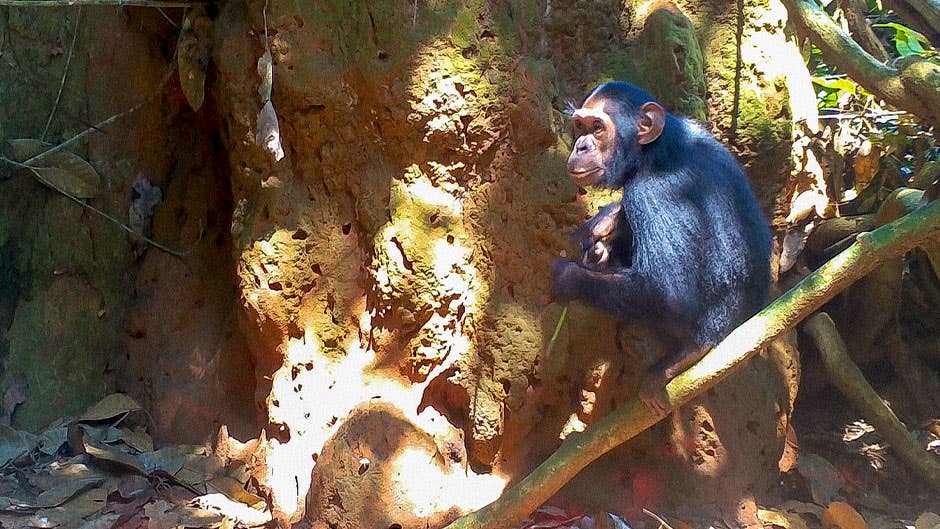Termite-fishing chimpanzees provide clues to the evolution of technology
Researchers who recorded a generation of chimpanzees learning to use tools, gain insights into how technology came to define human culture

[Aug. 19, 2020: University of Miami]
Researchers, who remotely videotaped a generation of wild chimpanzees learning to use tools, gain insights into how technology came to define human culture.
Using the now-ubiquitous manmade technology of motion-activated cameras, researchers who remotely watched 25 immature chimpanzees grow up have documented how humankind's closest relatives living in the Congo Basin acquire their unique tool skills for harvesting termites, a favorite nutrient-rich element of the chimpanzee diet.
Unlike chimpanzees in East and West Africa, who use a single tool to extract termites, chimpanzees in Central Africa's Congo Basin use tool sets--puncturing sticks or perforating twigs plus fishing probes--to harvest the insects from underground nests or towering earthen mounds scattered across lowland forests. Arguably, chimpanzees living in this region have the most sophisticated arsenal of tool-using skills documented in the animal kingdom. Not only do they use specialized tool sets to harvest termites, ants, and honey, but they customize the implements with different modifications to improve their efficiency.
Trying to untangle how chimpanzees in the Congo Basin acquire these complex tool tasks, University of Miami biological anthropologist Stephanie Musgrave screened thousands of hours of video that recorded visits to termite nests, including those by forest elephants, leopards, and gorillas, in the Republic of Congo's Goualougo Triangle. Her reward was identifying more than 660 hours of periodic visits by 25 young chimpanzees belonging to a notoriously elusive subspecies of chimpanzee (Pan troglodytes troglodytes). Recorded over 15 years, this footage captured the development of their tool-using skills from birth until maturity.
Like these kind of stories? Get The Brighter Side of News' newsletter.
Now, in the first study assessing when Central African chimpanzees learn to use and make their unique termite-extracting tool sets, Musgrave and fellow researchers with the Goualougo Triangle Ape Project provide novel insights into how chimpanzee cultures persist over generations--and perhaps how technology came to be a defining aspect of human evolution.
"Chimpanzees have the most complex tool behaviors of any animals outside of humans, so studying how their youngsters become proficient at these tasks can help us better understand how early humans might have acquired complex technological skills," said Musgrave, an assistant professor in the Department of Anthropology and lead author of the study published in the American Journal of Physical Anthropology.
"Examining the development of these perishable tool kits is of particular interest because our ancestors likely also used perishable tools--made of plants rather than stone--but these tools are not preserved in the archeological record," she added.
For their study, Musgrave and her co-authors--Elizabeth Lonsdorf, David Morgan, and Crickette Sanz--conducted the first, direct comparison of tool skill acquisition between two populations of chimpanzees, those at Goualougo and those more than 1,300 miles to the east, in Gombe, Tanzania.
Lonsdorf, a professor of psychology at Franklin & Marshall College, studies chimpanzees at Gombe, the oldest field study of wild chimpanzees established by renowned primatologist Jane Goodall 60 years ago. Morgan, of Chicago's Lincoln Park Zoo, and Sanz, of Washington University in St. Louis, co-founded the Goualougo Triangle Ape Project--the longest-running behavioral study of wild Central African chimpanzees. And, in partnership with the Wildlife Conservation Society, they have studied this population of chimpanzees for more than 20 years. They also pioneered the use of remote video technology to study wild chimpanzee behavior.
For their current study, the research team adapted the methods developed at Gombe for studying the acquisition of tool skills. And, they found notable differences in the timing and sequence in which the chimpanzees in these two populations acquired their termite-gathering skills--differences that could relate to the challenges of using and making multiple tools at Goualougo.
While infants at both Goualougo and Gombe begin trying to use tools within their first two years, the Gombe youngsters learn to make their tools before or at the same time they become proficient at using them. In contrast, the Goualougo youngsters learn to termite fish before acquiring their tool-making skills. In early life, they typically use tools that have been discarded or transferred to them by other, older chimpanzees.
Unlike the Gombe chimpanzees, who use varied materials, the Goualougo chimpanzees also carefully select the materials for their tools, almost always from just a few species of plants. And they modify them to improve their efficiency.
"They have a mental template of the right tool for the job, and there's no mistaking the different tool types," Musgrave said. "Puncturing tools are made from a species of tree that's very durable and resistant, while fishing probes are made from smooth, pliable stems of vegetation. In contrast to Gombe, the chimpanzees at Goualougo fray these probes with their teeth to manufacture a paint-brush-like tip, which makes the tool 10 times more efficient at capturing termites."
After learning to make their own tools, Musgrave discovered, the Goualougo chimpanzees begin to employ them sequentially--using a perforating twig plus a fishing probe to harvest the termites that inhabit the above-ground nests and a puncturing stick plus a fishing probe to extract them from the much-harder-to-pierce underground nests. The latter task is so arduous that the researchers predicted it would be the last mastered and just by a few chimpanzees. They were right.
"I've observed chimpanzees make hundreds of attempts to puncture into a subterranean termite nest," Musgrave said. "Not only does the skill require immense strength but also technical competencies that may continue to develop in adolescence."
The findings underscore how the developmental trajectory of life skills can vary considerably depending on the task and across chimpanzee populations, which have unique local cultures. In the study, the researchers note that the variation in tool traditions between sites could be linked to differences in the role of social input from other chimpanzees.
"In previous research, we documented that mother chimpanzees at Goualougo play a more active and helpful role when compared to mothers at Gombe," Musgrave said. "At Goualougo, mothers are more likely to transfer tools to their offspring. This enhanced assistance could be instrumental in the acquisition of skills over the longer time period."
Figuring out how tool traditions are passed on and how this differs within and between species, Musgrave said, could help humans understand the emergence of cumulative culture during our own evolution.
"One of the key features of human culture is its remarkable complexity," she said. "It's what we call cumulative. Meaning that ideas and innovations accumulate over time, such that new generations inherit and learn to use technologies that are far more complex than any one individual could invent. Comparative studies give us insights into how technology came to be a defining aspect of human evolution."
But, as Musgrave cautioned, the continuation and expansion of such research depends on the long-term preservation of wild chimpanzees and their cultures--which are increasingly endangered by human activities.
Joseph Shavit
Head Science News Writer | Communicating Innovation & Discovery
Based in Los Angeles, Joseph Shavit is an accomplished science journalist, head science news writer and co-founder at The Brighter Side of News, where he translates cutting-edge discoveries into compelling stories for a broad audience. With a strong background spanning science, business, product management, media leadership, and entrepreneurship, Joseph brings a unique perspective to science communication. His expertise allows him to uncover the intersection of technological advancements and market potential, shedding light on how groundbreaking research evolves into transformative products and industries.



